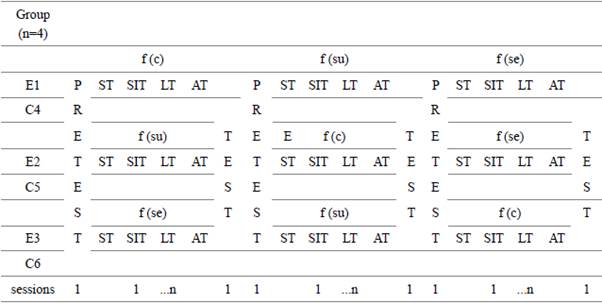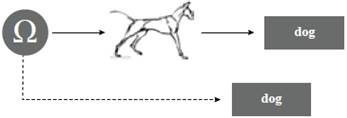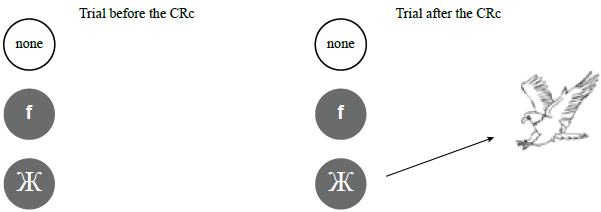Introduction
In the ontogenetic development of an organism, the history of interaction with objects / events in the environment is the differentiating factor between psychological and biological behavior. Among the different theoretical systems for the analysis of behavior, interbehavioral theory proposes its study based on the system of contingencies (dependency relationships) that are structured in interaction, and it is named interbehavioral field or psychological function (Kantor, 1924-1926; Kantor, 1959). Under this logic, Ribes and López (1985) proposed the study of psychological behavior through a taxonomy of five progressively complex and inclusive levels of functional organization. From lower to higher degrees, these levels are called: contextual, supplementary, selector, referential substitution and non-referential substitution. This way of conceptualizing psychological behavior allows us to study the qualitative and quantitative evolution of each type of interaction, recognizing its differentiating and binding elements (Ribes, 2004; Ribes, 2007).
In general, interbehavioral theory assumes that the psychological phenomenon is not in the organism or its action, but in the interactive system in which it participates. According to Ribes and López (1985), the functional organization of psychological behavior can be configured in qualitatively different ways concerning the contingency system involved in the organism-environment interaction. Of all the elements involved in the interaction, three of them could be considered the most relevant in differentiating the qualitative structure of each level of the functional organization, namely: 1) the mediator, a critical element in the structuring process of the contingency system involved in the stimulus-response function; 2) the functional detachment, which occurs when the response diversifies, transforms and expands functionally, promoting a particular type of interaction in virtue of the reactive capacity of the organism (given by its ontogeny and phylogeny) and the characteristics of the environment (given independently and/or interdependently of the activity of the organism); and 3) the type of behavioral adjustment, which supposes the way whereby the response adjusts functionally to the contingency system in which the organism/individual interacts (e.g., Ribes, 2004; 2007; Ribes & López, 1985).
The first three types of functional organization proposed by Ribes and López (i.e., contextual, supplementary, and selector) are characterized by the fact that in the interactions in which the organism participates, its reactivity is linked to the contingencies of the situation (ie, interactive system), without transcending it, which is why they are called intra-situational functions. The situation may include physical-chemical, ecological and/or conventional events, whose stimulus properties can be constant and/or changing (relative) as required in the interaction. The conditional relationships between potential and/or effective events that are linked to the behavior of the organism/individual establish the interaction situation, being less relevant the particular place where the behavior occurs (Torres, Ortiz, Rangel & González, 2012). Regarding the last two types of functional organization (referential substitution and non-referential substitution), the behavior of the organism is detached from a particular situation to transit or build, respectively, a contingency system or situation of a different nature. The characteristic reactivity of these last two functions is only possible in human organisms that develop in linguistic/social environments. Therefore, it is not enough that several organisms interact with each other in the environment, for that environment to be social. Only if the response to objects and/or individuals is conventional, in the sense that those who participate in the interaction implicitly and/or explicitly agree on the joint response to these, the environment is considered to be social (Ribes-Iñesta, 2001; Ribes- Iñesta, Rangel & López-Valádez, 2008).
In just over three decades from the origin of taxonomy, empirical scrutiny of data related to the complexity and inclusiveness of psychological functions is meager. Furthermore, there are a large number of cases of psychological functions proposed by Ribes and López (1985) and Ribes (2007) for which there are no empirical data. For example, the case of the reference to the referee/referrer and the case of contingencies of events at different times that occur in the same spatial location. Although the problems of correspondence of the theories concerning the phenomena that they describe and/or explain are "solved" through conceptual and logical analyzes, empirical research allows to refute/accept the particular hypotheses that derive from the general approaches of a theory. Both tasks are relevant to scientific work. In this sense, this research aims to analyze empirical data that could be related to the complexity and inclusiveness of psychological functions.
Serrano (2009) carried out an investigation to evaluate the complexity and inclusivity of intra-situational functions. For such purposes, he exposed rats (Wistar strain) to different situations of water delivery corresponding to three stimulus programs (e.g., Schoenfeld & Cole, 1972): contingent, non-contingent and conditional contingent. In the td sub-cycles of each program, the possibility of water delivery was indicated with red or green LED lights related to different response conditions, according to the current program. The situations were designed to carry out the evaluation and training of the contextual, supplementary and selector function, respectively, each lasting 30 sessions. In the non-contingent situation, the delivery of water did not depend on the rat's response, since it was delivered right after the activation of the red light, regardless of any response. Thus, when the subject differentiated the light-water relation, the frequency of water consumption could be increased. On the other hand, in the contingent situation, the response to a lever was necessary for the delivery of water, although the response was only effective at the appearance of the red light. Finally, in the conditional contingent situation, water delivery depended on the response to a right or left lever, regarding the water dispenser, conditional on the occurrence of a red or green light. This situation involved the precise response concerning two response conditions: 1) red light-response to the left lever and 2) green light-response to the right lever.
All the subjects were exposed to the experimental situations concurrently in a quadrangular space with four activity panels (a water dispenser, two levers and LED lights). Each water delivery schedule was available on one of three activity panels, leaving the fourth panel without scheduled consequences. In general, the results showed a progressive decrease in the adjustment index (unit of the measure proposed by the author) regarding the increase in the complexity of the behavior evaluated and trained in experimental situations. Although this finding was presented as evidence related to the complexity of the adjustment criterion (Serrano, 2009), it highlights the fact that the indices achieved by the subjects in the contingent and conditional contingent water delivery situations were close to zero. Apparently, there was no consistent effect related to manipulations, which makes it difficult to analyze the transit between experimental situations, a datum related to the complexity and functional inclusivity.
Subsequently, Serrano (2016) carried out a similar study in which he exposed three rats, of the Wistar strain, to a sequence of 10 sessions of water delivery under the non-contingent, contingent and conditional contingent conditions. Regarding the reference study, the modality of stimuli changed from visual to auditory. The results were similar to those of Serrano (2009), although precision was made in the formulas to obtain adjustment indices that better reflected the level of interaction evaluated. In summary, due to the poor performance shown by the rats in the tasks, the facilitating effect of the interaction history at a level of functional aptitude of certain complexity on behavioral adjustment at another of greater/less complexity was neither observed. Furthermore, although in both studies the adjustment index decreased concerning the complexity of the task faced, the adjustment index approached zero in the two tasks of greater complexity.
Taking into account the above, in future studies, an "optimal" level of performance to transit to a more/less complex task could be considered. If this criterion is adopted, the effect of partially adjusted or adjusted fields or functions (as a trend, not as an achievement; see Ribes, 2007) on the adjustment process in other functions could be observed, instead of observing the effect of the transition between situations, regardless of the level of adjustment achieved.
Moreover, Ribes, Vargas, Luna, and Martínez (2009) obtained results that could be considered evidence against the inclusiveness assumption. In their study, they trained participants to respond in structured tasks concerning the five levels of functional organization. All participants were exposed to pretest and posttest sessions for each of the functional levels but were assigned to one of six groups that differed by type and number of training sessions. Group 1 received training sessions of the five levels, Group 2 to four (from the second most complex function to the fifth) and so on until reaching Group 6 that received no training. The behavioral measure used was the percentage of correct answers obtained by participants in the experimental sessions. In general, the results showed that it is possible to attain an effective performance at a level of functional organization of greater complexity, without explicit training at the functional levels that precede it.
Despite the results found so far, the state of research in the area is barely developing. Therefore, there is a need to design and test measurement and experimentation methods that allow elucidating the complexity and inclusiveness of each of the levels of functional organization proposed in Ribes and López' taxonomy (1985).
Bearing in mind that the empirical evidence focusing on improving the understanding of the inclusiveness and progressive complexity assumption (Ribes, et al. 2009; Serrano, 2008; Serrano, 2009) is not very robust, the purpose of this research was to carry out an exploratory study aimed at adding data to the analysis of intra-situational functions through a novel experimental task. Specifically, evaluating the performance of university participants in three experimental situations related to levels of functional organization of different complexity was proposed. These tasks were presented in three different sequences: ascending, descending-ascending, and descending. Furthermore, in order to obtain data related to functional complexity, the learning process in the structuring of the three intra-situational functions without a history of previous functional aptitude was compared. Regarding inclusivity, the effect of the functional adjustment history on ascending and descending transitions was analyzed.
Method
Design
A multi-conditional experimental design of repeated measures "3-in" (sequences) and "4-in" (training sessions) was used, with control groups. The conditions "between" were: 1) ascending (contextual-supplementary-selector), 2) descending-ascending (supplementary-contextual-selector) and 3) descending (selector-supplementary-contextual). In combination with the previous condition, there were four training sessions on responses to stimulus properties, namely: I) species, II) size, III) motor, IV) all (species-size-motor).
This last manipulation was designed to train responses to absolute-constant and relative-variant properties of stimuli. Control groups received no training; all groups consisted of four participants, who interacted in one pre-test session and one or more test sessions from each level of functional organization. Only the participants of the experimental groups could interact in the training and/or test sessions on more than one occasion.
The advancement to the next session was conditioned to the achievement of an Adjustment Index (AI) equal to or greater than 0.8 in the contingency arrangement (the unit of measurement will be described later). When the participant did not obtain an AI equal to or greater than 0.8 in a training session, he/she had to interact in the same session again until reaching said index. If they could not reach this AI in some of the test sessions, they had to interact at the last training session again and then interact in the test session once more. The maximum number of opportunities to reach the AI of 0.8 was three sessions; the participants who did not reach this criterion were discarded from the study, thanking them for their participation. There were four types of training sessions, concerning the type of stimulus property to which the response was related during the interaction, namely: 1) species, 2) size, 3) locomotion, and 4) all (species-size-locomotion). All the experimental situations included these four types of training, exposing the participants to each one of them, in the order described. Once the participant reached the performance criteria in the session (AI equal to or greater than 0.8), he would go to the next session if this was training or to the next experimental situation if this was a test (in the case of being the third contingency arrangement, the experiment ended) (See Table 1)
Participants
Through a non-probabilistic sampling, 24 university students of the psychology degree course were selected (3 men and 21 women; average age 22 years). They belonged to different educational institutions in the Guadalajara Metropolitan Area, one public and two private. Everyone lacked experience in the experimental task and were contacted through their teachers, who encouraged them with credits in their subjects for participating in the experiment.
Apparatus, Equipment and Experimental Situation
Four cubicles semi-isolated from noise and isolated from visual stimuli outside the experimental task were used. Inside the cubicles were a chair and a table with an HP brand computer with a Windows XP environment, a chromatic monitor for the presentation of experimental tasks, and a mouse to respond to stimuli. The programming of the experimental tasks and the recording of responses were performed with SuperLab 2.0.4 © software.
Experimental tasks
According to the level of functional organization to be measured and trained, a different experimental task was used in each case to enable the interaction situation. The stimuli were black and white animal drawings which varied in: a) species (i.e., dog, bull, elephant, hummingbird, seagull, eagle, tuna, dolphin, and whale), b) size (i.e., small: "dog, hummingbird, and tuna"; medium: "bull, seagull, and dolphin"; large: "elephant, eagle, and whale"), and c) predominant locomotion means (i.e., walk: "dog, bull, and elephant", fly: "hummingbird, seagull, and eagle"; swim: "tuna, dolphin, and whale"). Symbols enclosed in different colored circles that related to one of the drawings categories were also used. Those of blue color related to the species category represented in the drawings. The symbols in green color circles were related to the locomotion category (walking, flying, and swimming). While those of yellow color were related to the size category (small, medium, and large), regarding the locomotion group to which each species belonged. When there was no symbol related to the drawing in the stimulus arrangement of the trial, a circle with the word "none" gave the option to "omit the answer". In most of the trials the correct answer was by inclusion and only in some of them by omission. The omission response option could be present, both in trials where it was pertinent to give or omit the answer (See Table 2).
The contextual contingency arrangement began each trial with the presentation, for two seconds, of one of the symbols on the left side of a white screen. Subsequently, an arrow appeared for three seconds, on the right side of the symbol, followed by the corresponding drawing according to the training or test phase (See figure 1). Between trials, a black screen was presented for half a second, to which, a sentence that read: "Remember, it is important to pay attention" was added intermittently.
Table 2 Stimulus matrix showing the symbols to which each drawing was related.
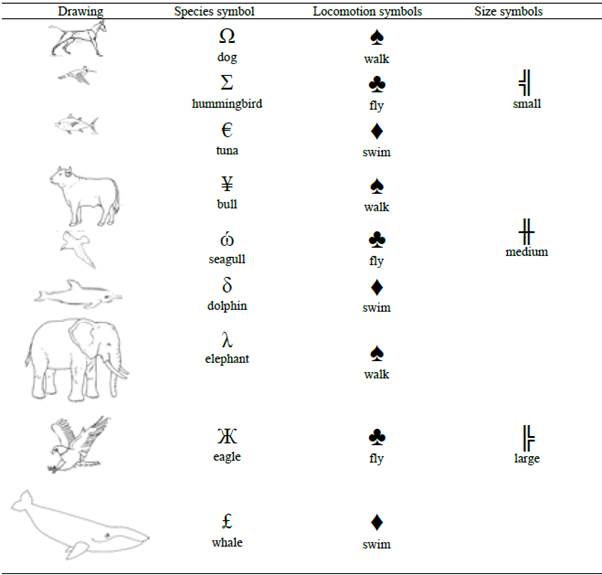
Note. Circles of different colors contained the symbols to facilitate discrimination. The blue, green and yellow color was related to species, locomotion, and size properties, respectively.
Regarding procedure, the training sessions were composed of two sub-sessions, one of observational training (previously described trials) and the other of evaluation. The stimulus arrangement of the evaluation trials was organized horizontally, with a symbol on the left side of the screen and three boxes on the right side with words inside; the screen background was white (See figure 2). Both types of trials occurred randomly. In some trials in the evaluation sub-session, a rectangle with the word "none" appeared. Regarding the procedure, the pretest and test were identical to the observational training sub-session used to evaluate the exposure to the observational trials. Participants did not receive any feedback on their performance in any of the test sessions. The number of trials for each session varied regarding the type of training or test (i.e., pretest, training, and test).
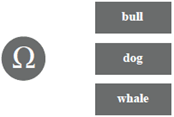
Figure 2 Contingency arrangement of contextual type trial, assessment sub-session (training, pretest and test).
The contingency arrangement of supplementary type began each trial displaying three circles aligned vertically on the left side of a withe screen. One circle contained a symbol and the other two circles enclosed alphabetical letters, with the purpose of highlighting the symbol between the letters. Occasionally, one of the two circles contained the word "none" instead of a letter. The participant responded in the trial by "clicking" on a circle. If the response was to the circle with a symbol, an arrow next to it appeared on the right side of the symbol followed by a drawing. When the response was to a circle with the word "none" and the other two circles contained letters, the word "correct" appeared on a new screen for two seconds. When the response was to the circles that contained letters, the sentence "incorrect response" appeared on a new screen for two seconds. The answer to the circle with the word "none" was also considered an incorrect response when there was a circle with a symbol in the trial. After feedback, a new trial started. Sessions ended when the participant had been exposed twice to each of the symbols corresponding to the training session.
Testing sessions of the contingency arrangement of supplementary type did not include letters, but only symbols and, in some trials, a circle with the word "none". The contingency arrangement of the testing trial required the participants differentiation of each symbol-drawing relation supplemented, instead of the response to the only circle with a symbol. The stimulus arrangement was similar to the training arrangement, but with a drawing on the right side of the screen. Among the three symbols, only one of them corresponded to the drawing. If it was selected, an arrow appeared between the symbol and the drawing; when it was not, a new trial started (See figure 3). The pretest and test were designed to assess whether the participants differentiated each symbol-drawing function presented in the session, the reactivity necessary to respond effectively.
For the evaluation of the precise adjustment (selector condition) the experimental task had a typical contingency arrangement of a first-order matching-to-sample task. Each trial simultaneously contained a drawing at the top of the screen and four circles at the bottom. Almost all the circles contained symbols, except for a few trials in which the word "none" was presented inside one of them. During the training sessions, participants received continuous feedback for each of their corrective trial choices. This change in the procedure, regarding the previous tasks, was made because when piloting the task without corrective trials, the participants required more sessions to reach the adjustment criterion. Concerning the qualitative part, the task became more complex because the same drawing was related to different symbols depending on the response moment. Thus, the relevance of the response changed from one trial to another according to the stimulus arrangement presented, so that while in one trial it was relevant to respond to size, in another it was to its locomotion or to the species of animal represented in the drawing (See figure 4).
In this contingency arrangement of the selector type, if the response was to the circles containing the symbol corresponding to the drawing or the word "none" when there was no corresponding symbol, the word "correct" appeared on a new screen for two seconds and, subsequently, a new trial started. But if the response was to the circles with a symbol that did not correspond to the drawing or that contained the word "none" when there was a corresponding symbol in the trial, the phrase "incorrect response" appeared for two seconds and the trial appeared again until the participant gave a correct response. In both the pre-test and the test, there was no feedback for their performance.
The measurement unit to assess the participant's performance in the experimental tasks was the Adjustment Index (AI). The unit shows the tendency of the participants to adjust their response to the circumstances of each task in a session, through the following formula:
IA index results from the subtraction of the Correct Responses (CR) minus the Incorrect Responses (IR), divided by the Total Responses (TR) programmed in a session, equivalent to the number of trials. In some trials of the experimental tasks there was a non-response option when none of the response options was pertinent. In a trial the participant response could be classified as CR by inclusion and by omission, as well as IR by inclusion and omission. The response to stimuli to which it was pertinent to respond in a trial was classified as CR by inclusion and the response to stimuli to which it was not pertinent to respond IR by inclusion. In some trials, the option of "non-response" was available by selecting a circle with the word "none" between the stimuli. If the participant selected the non-response option and there was no stimulus in the trial to which it was appropriate to respond, the response was considered CR by omission. Finally, the IR by omission were those in which the "non-response" option was selected in a trial with a stimulus to which it was pertinent to respond. The study considered that the particularity of the response adjustment (i.e., differential, effective, precise) derived from the contingency arrangement in which the participant responded (i.e., contextual, supplementary, and selector, respectively).
Procedure
The study started with the entrance of the participants to the experimental cubicles, where it was explained to them that the research focused on the study of learning. Subsequently, the participants received the informed consent form. If they agreed, they signed it and received pertinent instructions to respond in the contingency arrangements. The experimenter commented that the instructions would appear on the monitor, that they had to respond by manipulating the "mouse", clicking the left mouse button, and that the duration of the experiment could be approximately two hours. After offering the above clarifications, the person in charge of the experiment left the cubicle and closed the door.
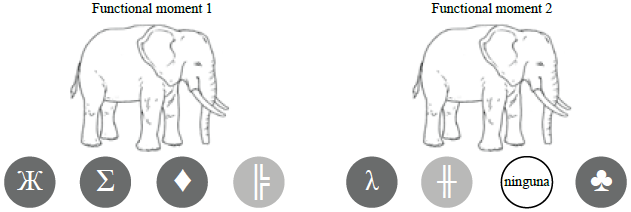
Figure 4 Contingency arrangement of selector type. The pertinent response in the Functional moment 1 is the symbol "╠" selection; in the Functional moment 2 is the symbol "λ".
For each experimental session, the first slide presented the institutional data from the research center where the study was carried out. The following slide welcomed the participants to the session and specified the contingency arrangement that they were going to face (ie, pretest, training, test). The specification was programmed to avoid that the response could be affected by the similarity of contexts without any added signal that would allow them to be differentiated. This effect was found in some studies that use matching-to-sample tasks of first-order (e.g., González & Ortiz, 2014). On the same slide there was a general instruction that varied in relation to the session in which the participant was engaged (See Table 3).
Table 3 Instruction types for each testing and training session according the contingency arrangement
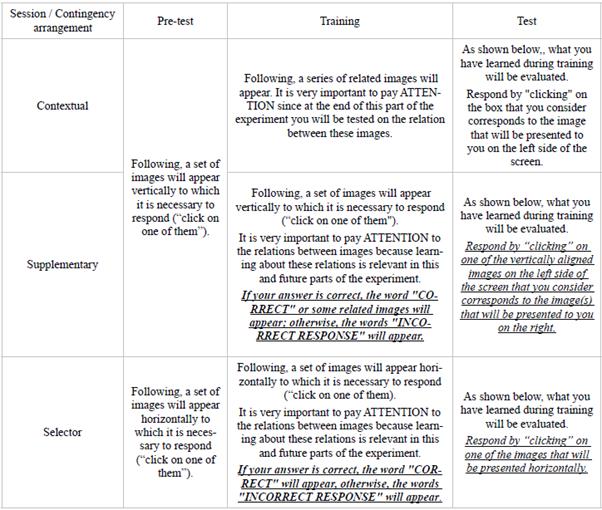
The participants of the control groups were exposed to a pre-test and test session of the three experimental tasks, varying the exposure sequence concerning the assigned group. No participant in the control groups was exposed to training sessions, ending their participation in the study in approximately 50 minutes.
Because of the nature of each of the psychological functions studied, the way of training and evaluating varied not only in terms of stimulus arrangement but also in terms of the number of trials for each experimental task. However, it was sought to homogenize the number of trials in the pretest and test sessions with 18 trials, nine to assess the relations to the species category, three to locomotion, three to size and, three non-response trials.
The differential adjustment training of species, size, and locomotion training consisted of 10 trials, nine to relate the symbols to each drawing and one to omit a response. Finally, the training session for all the functions consisted of 18 trials, nine to relate the symbols to the species category, three to locomotion, three to size and, three to omit the response.
The effective and precise adjustment was trained in 21 trials concerning the species represented in the drawings, 18 to relate each symbol twice to its corresponding drawing and three to omit the response. The response training to the size or locomotion consisted of 27 trials. Each symbol was related twice to each drawing regarding its size or locomotion, but, in addition, it was related twice to the group of drawings to which they corresponded (i.e., in the same trial the tuna, dolphin, and whale appeared matching the rhombus/diamond), plus three trials to omit response. The training of effective responses to all the categories of the stimuli (species/locomotion/size) consisted of 36 trials, 18 for the species category, six for locomotion, six for size and six for omitting response. There was a considerable increase in the number of trials in the contingency arrangement of precise response to all drawing categories, with a total of 76; 18 related to species, 24 to size, 24 to locomotion, and 10 to omit response. Out of 24 trials for the training of size response and locomotion, 18 were for one-to-one relations and six for one-to-many relations, in other words, a symbol-one drawing or symbol-three drawings, respectively.
The contingency arrangement of precise adjustment training was divided into four phases for each category (species, size, locomotion, and all) because training only all the categories was very complex. In a pilot test out of 10 participants none could show an Adjustment Index close to 0.8 after four sessions of 76 trials each, even though the procedure was corrective. Therefore, the training had four phases. For each of the contingency arrangements to be comparable, the less complex arrangements (i.e., contextual and supplementary) also had four phases, but the number of trials was reduced in relation to functional complexity to decrease the time of the experiment and diminish the probability that fatigue could interfere with the results.
Data analysis
The Mann-Whitney U test was used to analyze the differences in the results of participants in Group 1, 2 and 3 in the first task they responded, tasks that varied in degree of complexity. The data analyzed were the number of sessions necessary to reach the adjustment criterion in the post-test.
Results
The data graphed was the Adjustment Index (AI) that the participants obtained in each of the sessions of the experimental phases of the contingency arrangements to which they responded. The results of each group of participants were organized into figures with 12 graphs (i.e., on the axis of the ordinates the AI obtained and on the axis of the abscissa the number of sessions) arranged in three columns and four rows, corresponding to the execution of a participant in different contingency arrangements; each column shows the performance of the participants in the same group in a contingency arrangement. The figures are differentiated by the sequence of exposure to contingency arrangements, representing the performance of a group of participants.
The representation of the AI shown by the participants in each session was graphed as follows: a) a gray bar placed on the far left of the graph for the pretest, b) one or more gray bar(s) on the right end of the graph for the test (depending on whether or not the functional adjustment criterion had been reached, each bar represents an exposure to the test session) and, c) isolated or line-joined circles and squares to training (circles and squares were joined with a line when the participant had to expose himself to more than one session for not having reached the adjustment criteria in that session). From left to right, the first circle corresponds to the performance in "species training", the first square for "size training", the second circle for "training locomotion" and the second square for "training all" (species/size/locomotion).
In addition to the previously described characteristics, the graphs present a horizontally segmented line that indicates the functional adjustment criterion (= or > 0.8) to advance to the next session. In some cases, the graph had a number less than -0.2 to indicate the AI that could not be represented in the graph with a bar of greater length. Finally, regarding the generic description of each of the graphs, a label at the top of the graph columns indicates the type of contingency arrangement. In this sense, the label f (CO) indicates the column of graphs that represent the differential AI in the contingency arrangement of the contextual function, the f (SU) symbolizes that of the effective AI in the supplementary function and the f (SE) depicts that of the precise AI in the selector function.
Figure 5 shows the results of Group E1 (contextual/ supplementary/selector), where four participants obtained a differential AI less than or close to zero in the pretest. During training, three participants achieved, on their first attempt, the functional adjustment criteria in each of the sessions, as well as in the test. Only participant P2 required four sessions in "species training" and three sessions in "locomotion training" to achieve the functional adjustment criteria, adding 11 sessions in the contextual contingency arrangement (CA).
Regarding the participants' performance in the supplementary and selector CAs, results show almost all of them exceeded the AI value of 0.8 in one session in the pretests and tests. Only participants P1 and P2 had to face more than six sessions in any of the subsequent CAs of the contextual type.
Figure 6 shows the performance indexes of the Group E2 participants, who faced the supplementary CA first. Four participants obtained an AI near to zero in the first pretest, similar data to that of the participants in Group E1. However, three of the four participants showed considerable differences in terms of the increment of the number of sessions required to achieve the adjustment criteria in the training and/or test sessions (i.e., P6 with 9 sessions, P7 with 12 sessions and P8 with 9 sessions). Regarding the AI obtained in the following two CAs (contextual and selector), results showed that almost all the participants required the minimum number of sessions for the conclusion of all the experimental phases, except for participant P7, who required 7 sessions in the contextual CA.
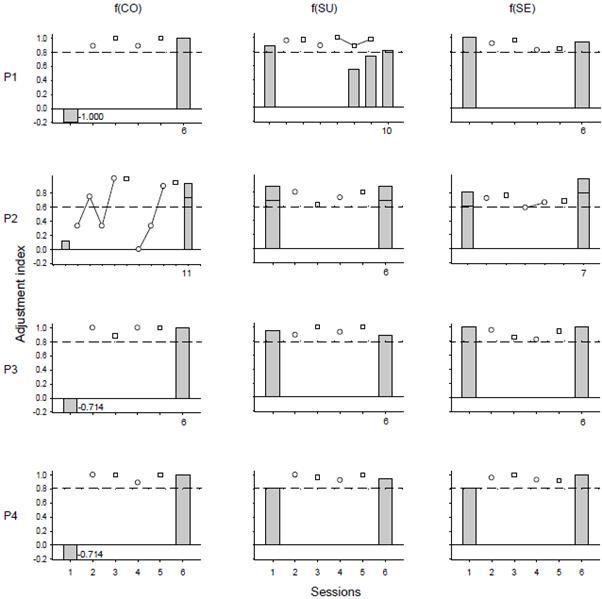
Note 1. f(C) = contextual function, f(SU) = supplementary function, f(SE) = selector function, P = Participant. Note 2. bars show pretest and posttest performance from left to right, respectively; the circles and squares symbolize the performance in the training sessions and the dashed horizontal line located in the Adjustment Index of 0.8 indicates the adjustment criterion to proceed to the next session.
Figure 5 Group E1 participants Adjustment Indices (contextual /supplementary / selector).
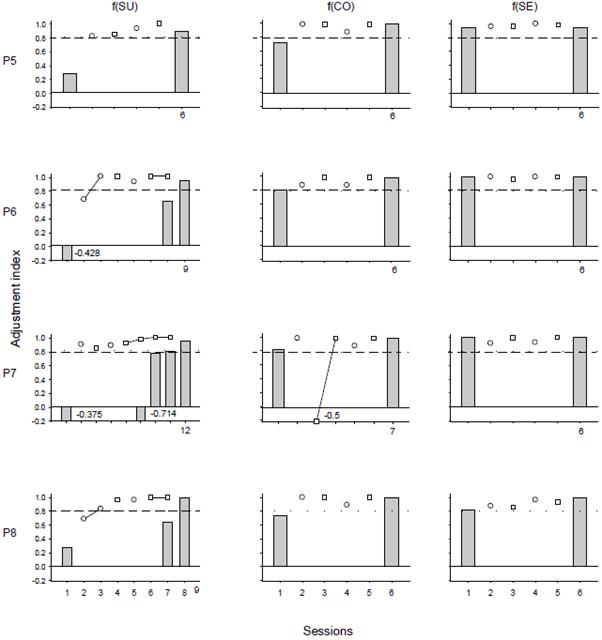
Note 1. f(C) = contextual function, f(SU) = supplementary function, f(SE) = selector function, P = Participant. Note 2. Bars show pretest and posttest performance from left to right, respectively; the circles and squares symbolize the performance in the training sessions and the dashed horizontal line located in the Adjustment Index of 0.8 indicates the adjustment criterion to proceed to the next session.
Figure 6 Group E2 participants' Adjustment Indices (supplementary / contextual / selector).
The Group E3 participants' performance is shown in Figure 7. It highlights that, regarding the performance in contingency arrangements in which the participants lacked functional aptitude history, more sessions (between 10 and 15) were required to achieve the precise adjustment criterion in the CA selector training and testing sessions. Participants had to be exposed two or more times to almost all sessions to achieve the adjustment criterion. In two participants that effect was more acute, who were exposed to more than one test session (P9 and P12). Concerning the pretest and test results in the following CAs (in this case supplementary and contextual), it can be seen that the minimum number of sessions was required to complete each task, except for P10 and P12, who required one more session (seven) in the supplementary CA.
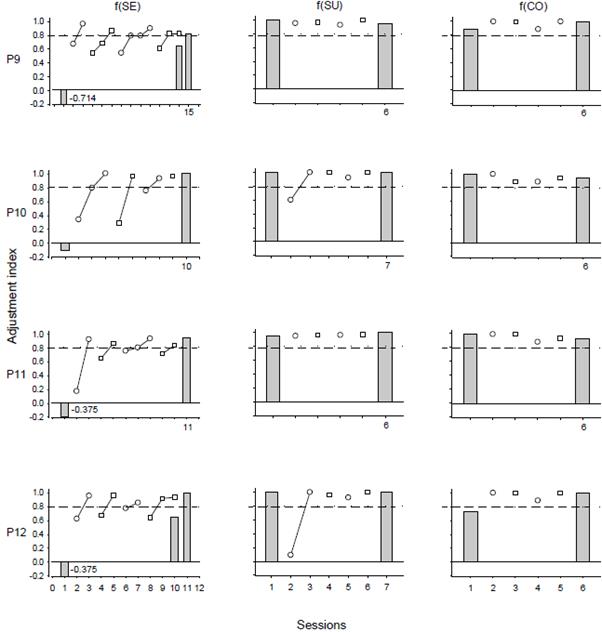
Note 1. f(C) = contextual function, f(SU) = supplementary function, f(SE) = selector function, P = Participant. Note 2. Bars show pretest and posttest performance from left to right, respectively; the circles and squares symbolize the performance in the training sessions and the dashed horizontal line located in the Adjustment Index of 0.8 indicates the adjustment criterion to proceed to the next session.
Figure 7 Group E3 participants Adjustment Indices (selector / supplementary / contextual).
Figures 8, 9 and 10 show the results of the control groups, who did not receive training but were exposed to the pretests and tests. Overall, the figures show that all the participants obtained an AI below or close to zero in the first CA to which they were exposed. When participants were exposed to the tests of the following CAs, some of them increased the AI, but, unlike what was registered in the experimental groups, none reached the adjustment criterion or showed progressive and sustained increases when accumulating experience in the following tests.
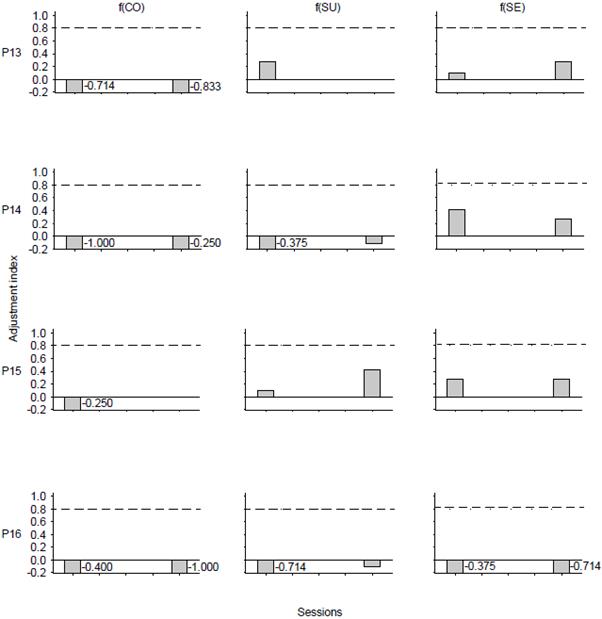
Note 1. f(C) = contextual function, f(SU) = supplementary function, f(SE) = selector function, P = Participant. Note 2. Bars show pretest and posttest performance from left to right, respectively; the circles and squares symbolize the performance in the training sessions and the dashed horizontal line located in the Adjustment Index of 0.8 indicates the adjustment criterion to proceed to the next session.
Figure 8 Group C4 participants Adjustment Indices (contextual /supplementary / selector).
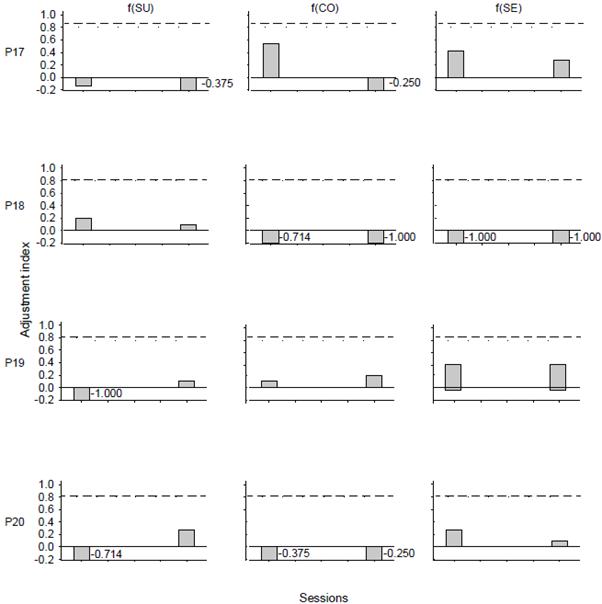
Note 1. f(C) = contextual function, f(SU) = supplementary function, f(SE) = selector function, P = Participant. Note 2. Bars show pretest and posttest performance from left to right, respectively; the circles and squares symbolize the performance in the training sessions and the dashed horizontal line located in the Adjustment Index of 0.8 indicates the adjustment criterion to proceed to the next session.
Figure 9 Group C5 participants Adjustment Indices (supplementary / contextual / selector).
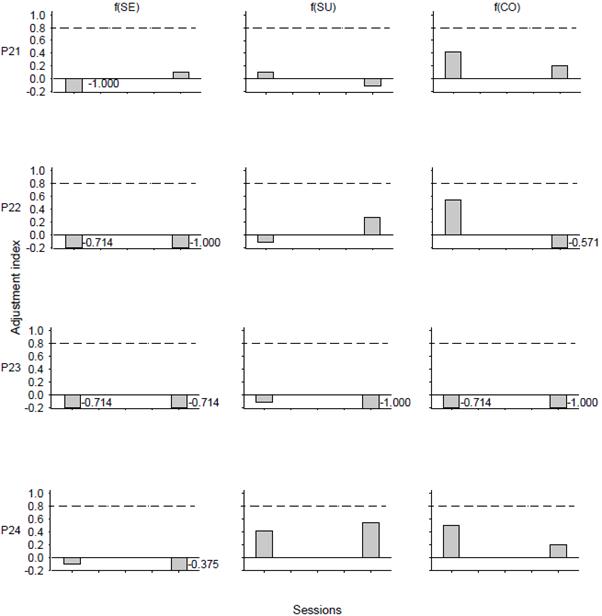
Note 1. f(C) = contextual function, f(SU) = supplementary function, f(SE) = selector function, P = Participant. Note 2. Bars show pretest and posttest performance from left to right, respectively; the circles and squares symbolize the performance in the training sessions and the dashed horizontal line located in the Adjustment Index of 0.8 indicates the adjustment criterion to proceed to the next session.
Figure 10 Group C6 participants Adjustment Indices (selector / supplementary / contextual).
Discussion
One of the objectives of the present investigation was to evaluate the effect of interaction history on the behavioral adjustment at three levels of functional organization of different complexity (i.e., contextual, supplementary, and selector). In this regard, the results show that a higher level of complexity in the functional organization of the interaction required a greater number of sessions, so that the participants, in the phase in which they had no history of interaction with the contingencies of the task, could reach or exceed the Adjustment Index. These data also showed that the history of interaction with the contingencies programmed in the task facilitated the learning of behavioral adjustment in functional organizations of different levels. Also, it was found that the history of interaction with the contingencies programmed in the task facilitated the learning of behavioral adjustment in functional organizations of different levels, regardless the functional complexity level of previous interactions. The control groups, which did not receive training, did not perform optimally in any of the tests at all levels evaluated, in the sense that the AI obtained by the participants was close to zero.
Results showed that the higher the level of complexity, the greater the number of sessions to achieve functional adjustment when the participants had no history of functional adjustment before training. From Group E1, which started with differentiation training (contextual), only one participant (P2) required more than six sessions to achieve the functional adjustment criterion to pass the test (exceed the AI of 0.8). In Group 2, three participants required more than six sessions to achieve the functional adjustment criterion for test effectiveness (requiring 9 to 12 sessions). In addition, Group E3 was the group that required the most sessions to achieve the functional adjustment criteria in the first phase of training. All participants of Group 3 required more than six sessions to show the adjustment level of functional precision that was expected of them in the task (requiring 10 to 15 sessions) (See Figures 5, 6 and 7). Serrano (2008; 2009; 2016) found similar results in some of his studies in which the increase in the complexity of the interaction was related to the worse performance of the experimental subjects. However, this similarity in the results must be analyzed in detail, since there are great differences between this study and the research cited regarding the method used to measure and promote each type of interaction.
Moreover, some participants from Group E1 (P1) and E2 (P6, P7, and P8) required two or more test sessions to achieve the adjustment criterion in the supplementary Contingency Arrangement (CA), even though they had achieved this criterion in the last training session (See Figures 5 and 6). Possibly these participants learned to establish relations between stimuli, as occurrences, without differentiating all the specific symbol-drawing relations in the training sessions. This result likely relates to the methodological differences between training and tests of supplementary CA. Whereas the participant in training only needed to differentiate that the response to the symbols was effective in relating them to some drawing, in the test he/ she needed to differentiate each specific symbol-drawing relation. Although in the supplementary CA the participants related the drawings to their respective symbols, it seems that the particular relations they found were no longer relevant and only "differentiated" that it was necessary to respond to the symbols and not to the letters. Assuming that the interpretation of these results was correct, when the participants were exposed to the supplementary CA test, they did not differentiate each particular drawing-symbol relation, whose aptitude was necessary to respond effectively to the task. Apparently, supplementing a relation between stimuli is not enough to respond effectively, considering it is necessary to differentiate the supplemented relation. However, since the interpretation of these results was made indirectly, it seems necessary to carry out experimental tasks showing data that can be directly related to the assumption of functional inclusivity between the contextual and supplementary functions.
Analyzing together the ascending sequences (the two from Group E1, Contextual-Supplementary and Supplementary-Selector; and, one from Group E2, Contextual-Selector) regarding interbehavioral history, it can be observed that training at a lower level of functional complexity facilitated performance at a higher level of behavioral complexity. In this regard, Velázquez and Flores (2013) found data related to the facilitation of effective adjustment (greater number of responses to a tone related to the delivery of water and a lower number of responses for each delivery of water) in participants with a history of contextual functional aptitude (pre-exposure to the tone-water relation). The authors considered that in their research the contextual functional adjustment history was not a necessary condition for the establishment of the supplementary function, since subjects without a contextual functional adjustment history were also able to adjust effectively.
Hitherto, the evidence found, in addition to that of the present investigation, suggests that the history of functional aptitude of a less complex function seems to facilitate the adjustment process in more complex functions (Serrano, 2009; 2016; Velázquez & Flores, 2013). But the evidence is insufficient to differentiate it from other factors that could also facilitate behavioral adjustment (i.e., biological state of the organism, situational factors). Likewise, it is considered pertinent to improve methodological aspects that allow elucidating differences in the facilitation of functional adjustment in descending sequences since the reported data do not enable differentiating it from the facilitation found in ascending sequences.
A study that contrasts with the results reported in this study, and those previously cited, is that of Ribes, Vargas, Luna, and Martínez (2009), who found that the structuring of more complex functions does not require, as a necessary condition, the structuring of functions of lesser complexity. However, there are again methodological differences between the studies that are worth reviewing in detail. Among these, it stands out that the study participants had previous experience in the relations of geometric figures, given their schooling (university students), which could facilitate their adjustment in the tasks. Regarding that, the proposal is to train relations that do not form part of the behavioral repertoire of the participants prior to experimentation (González-Becerra & Ortiz, 2014), as was done in this research.
A similar finding to that of Ribes et al. (2009) was found in the study by Tamayo and González-Becerra (2018). They conducted an experiment with primary school children exposed to training and testing sequences of intra-situational levels. Participants interacted with the properties of speed and number of wings of a "bug". After training the behavioral adjustment at different levels of complexity the adjustment index between groups was not significantly different. The learning rate was the same for adjustment at all levels of complexity, regardless of participants' behavioral history (regarding ascending or descending transitions in tasks of different complexity). Concerning this finding, Tamayo and González-Becerra (2018) considered that "the numerical aptitude" of the participants prevented the establishment of function contingencies, biasing the functional contact with the contingency arrangement programmed in each task.
Even though the results described in this investigation contribute to the study of the complexity and progressive inclusivity proposed in the taxonomy of Ribes and López (1985), aiming to obtain greater strength and consistency of the results and the corresponding interpretations, it seems important to rethink and reformulate some aspects that were involved in the present study, including:
To develop experimental tasks that, in addition to evaluating and training certain type of behavior, reveal evidence of the inclusion of less complex functions. The works of Serrano (2009; 2016) show progress in this regard.
To identify parameters that possibly relate to functional complexity and inclusivity. The analysis of the facilitation effect is not enough, since there are other elements of the contingency system that could be incorporated to improve the study of psychological functions (i.e., response sequences, partial or total contact with the stimuli involved in the interaction). For example, regarding the participants' performance in the supplementary contingency arrangement, it could be evaluated if by responding to symbols, rather than letters, they could differentiate each of the drawing-symbol relations they supplemented.
To specify that the "manipulation" of interbehavioral history as an "independent variable" does not imply that it is considered a necessary condition for adjustment, but rather a factor that modulates (i.e., facilitates) said adjustment. This distinction reduces the confusion regarding the status attributed to said variable in the interaction such as occurs when its level of participation in behavior analysis is not explicit (e.g., Okouchi, 2007; Pérez & García, 2010).
To propose analysis measurements and ad hoc methods to Interbehavioral Theory, a task pending nowadays for the behavioral analysts interested in molar analysis of inter-behavioral behavior, in which various researchers begin to explore some methods (e.g., Camacho, 2017; Meraz & Pérez-Almonacid, 2016; Serrano, 2009; Serrano, 2016).
To increase empirical evidence, carrying out studies evaluating different parameters of the behavioral adjustment processes in the structuring of psychological functions of different levels of complexity. For example, a subsequent investigation to the one reported here could evaluate the effect of the history of functional aptitude at a level of complexity on the adjustment index achieved in a function of different complexity (ascending or descending), but without going through a training phase.
Theoretical reflection and empirical evaluation of the correspondence between postulations and events in nature are complementary activities in the scientific work. A theory without empirical evaluation takes the risk of becoming a dogma, and an investigation without a theoretical framework limits the analysis to the particularities that the use of common sense may reveal. Nowadays, the study of the psychological functions proposed by Ribes and López (1985) provide some data related to their complexity and inclusive relations, but the evidence is not conclusive. However, there are available methods, measurements, data, and analyses that serve as the basis for future research.











 text in
text in 

